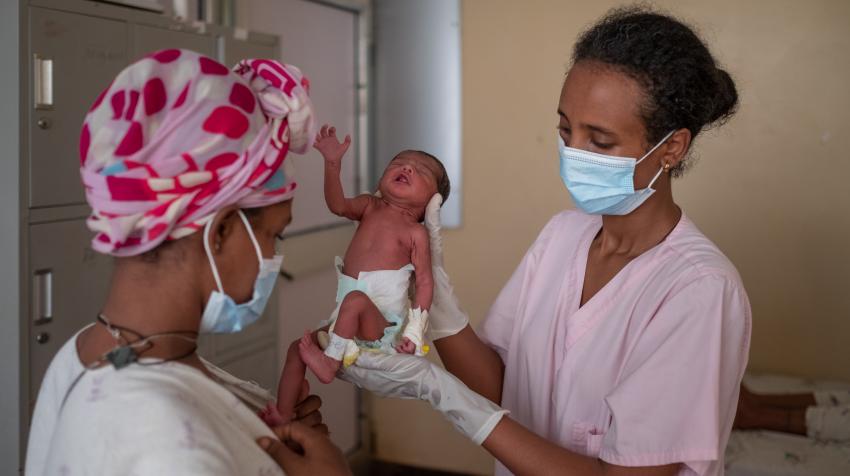As the international community marks World Patient Safety Day on 17 September, it is horrifying to see that global rates of maternal and neonatal mortality and morbidity remain far too high. In 2017 alone, 295,000 women died during and following pregnancy and childbirth. In 2019, 6,700 newborns died every day, 80 per cent of them from preventable and treatable conditions. Nearly 5,400 stillbirths occur each day.
This human burden is carried largely by low- and middle-income countries, by people living in conflict settings and among internally displaced populations and refugees. The link with conflict is particularly stark: maternal mortality increases by nearly 30 per cent in severe conflict settings. COVID-19 has made these communities even more vulnerable, because of disruption to health services. In fact, more than a third of 121 countries surveyed by the World Health Organization (WHO) reported disruption to essential sexual, reproductive, maternal, newborn, child and adolescent health (SRMNCAH) and nutrition services. Mexico and India, for example, experienced big increases in maternal death during the pandemic. Fetal outcomes have worsened too, with stillbirths now 1.29 times more likely in low- and middle-income countries.
Yet many of these deaths could be prevented simply through the provision of better patient safety and respectful care. Unsafe medication practices and errors are the leading cause of injury and avoidable harm in health-care systems across the world. Each year, unsafe care in low- and middle-income countries causes 134 million adverse events and 2.6 million deaths. Globally, four out of every ten patients are harmed in primary and outpatient health care. Among all countries of the Organisation for Economic Co-operation and Development, 15 per cent of hospital activity and expenditure results from these adverse events.
Providing respectful care means meeting the needs of communities and individuals, and taking women’s views and preferences into full account. Yet, sadly, many women giving birth experience unsafe, disrespectful, abusive or neglectful treatment. Some experience outright abuse, lack of confidentiality and gross violations of privacy. Others are refused admission to health facilities and neglected to the extent that they suffer completely avoidable, life-threatening complications. In addition to the direct impact on the women involved, this unsafe and disrespectful care undermines organizational reputations, staff morale and public trust, and discourages people from seeking the health services they need.
A WHO-funded study in The Lancet revealed that more than a third of women across 12 health facilities (three per country) in Ghana, Guinea, Myanmar and Nigeria reported mistreatment while giving birth in the period from 2016 to 2018. While disrespectful and abusive treatment may occur throughout pregnancy and the post-partum period, women are particularly vulnerable during childbirth. This is especially so for younger and less educated women, and the abuse often has direct, adverse consequences for both them and their child.

Although disrespectful practice already existed and has been documented in all settings, it has become more frequent during COVID-19. Examples in childbirth include: eliminating birth companions and banning visitors; separating mothers who have tested positive for COVID-19 and their babies, and preventing breastfeeding; augmenting labour or performing unindicated caesarean sections to control the timing of deliveries; and reducing length of stay with fewer home-based follow-ups.
The health-care workforce is at the heart of safe, high-quality care provision. Without them, we can’t provide any care, let alone make it safe or respectful. So, we must strengthen our human resources, with education and training, to build and maintain a competent, compassionate and committed workforce. We urgently need multisectoral action, increasing the number and distribution of personnel and providing supportive supervision, fair compensation, and protection from bullying and harassment in a safe and effective environment.
During the pandemic, the link between the safety of patients and health workers has become clearer than ever. Health workers have experienced increased anxiety and stress, higher workloads and burnout, with knock-on effects on quality of care. Vaccinations for health-care workers, who carry the highest risk of COVID-19 infections, are crucial. Yet, at present, less than 3 per cent of people living in low-income countries, including health-care professionals, have been vaccinated with at least one dose. We must correct that.
We urgently need more midwives as well. Midwifery is one of the most cost-effective means of achieving full SRMNCAH coverage and ensuring reproductive freedom for women. It reduces infections and has the capacity to end preventable maternal mortality and newborn deaths. But, despite their worth, there are nearly 1 million fewer midwives than required for global SRMNCAH services by 2030.
Maternal care and newborn care also are clearly and inextricably linked. Integrating the two and prioritizing safe and respectful care have a huge, positive impact on the health and well-being of mothers and newborns alike, as well as many wider indirect benefits. We must therefore explicitly address safety, as well as respectful and integrated maternal and newborn care services and interventions, ensuring that they are prioritized within preparedness and response plans.
All these investments in supporting pregnancy, childbirth and the first month of life will provide a quadruple return, saving mothers and newborns, reducing disabilities, and paving the way for optimal child development and lifelong well-being.
The Partnership for Maternal, Newborn & Child Health (PMNCH) is leading the way. We are a partnership of over 1,000 member organizations with a shared vision of securing the health and well-being of women, children and adolescents. A key part of our 2021-2025 strategy is prioritizing policy, service delivery and financing to support safe, respectful and high-quality maternal and newborn health. We also advocate for mothers and newborns in our COVID-19 Call to Action, with specific requests for better service delivery and quality of care, better human resources for health, and safe facilities.
But the world, as a whole, must do more. The longer we wait, the more women and children will die needlessly. We have no time to lose.
The UN Chronicle is not an official record. It is privileged to host senior United Nations officials as well as distinguished contributors from outside the United Nations system whose views are not necessarily those of the United Nations. Similarly, the boundaries and names shown, and the designations used, in maps or articles do not necessarily imply endorsement or acceptance by the United Nations.




